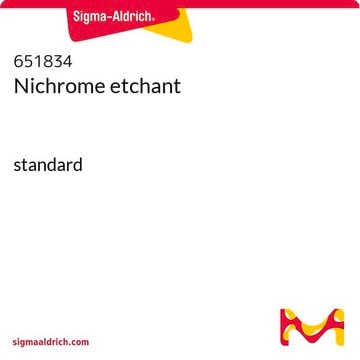Alle Fotos(2)
Wichtige Dokumente
GF42312305
Wolfram
foil, 2m coil, thickness 0.02mm, coil width .1mm, as rolled, 99.95%
Synonym(e):
Wolfram
Anmeldenzur Ansicht organisationsspezifischer und vertraglich vereinbarter Preise
Alle Fotos(2)
About This Item
Empirische Formel (Hill-System):
W
CAS-Nummer:
Molekulargewicht:
183.84
MDL-Nummer:
UNSPSC-Code:
12141747
PubChem Substanz-ID:
NACRES:
NA.23
Empfohlene Produkte
Assay
99.95%
Form
foil
Hersteller/Markenname
Goodfellow 423-123-05
Widerstandsfähigkeit
4.9 μΩ-cm, 20°C
Durchm. × Dicke × B
2 m × 0.02 mm × 0.1 mm
bp
5660 °C (lit.)
mp (Schmelzpunkt)
3410 °C (lit.)
Dichte
19.3 g/mL at 25 °C (lit.)
SMILES String
[W]
InChI
1S/W
InChIKey
WFKWXMTUELFFGS-UHFFFAOYSA-N
Allgemeine Beschreibung
For updated SDS information please visit www.goodfellow.com.
Rechtliche Hinweise
Product of Goodfellow
Hier finden Sie alle aktuellen Versionen:
Analysenzertifikate (COA)
Lot/Batch Number
It looks like we've run into a problem, but you can still download Certificates of Analysis from our Dokumente section.
Wenn Sie Hilfe benötigen, wenden Sie sich bitte an Kundensupport
Besitzen Sie dieses Produkt bereits?
In der Dokumentenbibliothek finden Sie die Dokumentation zu den Produkten, die Sie kürzlich erworben haben.
J R Marbach et al.
Physics in medicine and biology, 26(3), 435-443 (1981-05-01)
Curves relating beam energy, scattering foil thickness, central-axis depth-dose, and beam flatness have been generated using data taken on a Siemens 200A betatron. The curve set allows a single combination of tungsten foil thickness and electron beam energy to be
Congshang Wan et al.
Ultramicroscopy, 119, 106-110 (2011-11-15)
Thermionic electron emission from 200 to 500 nm thick coatings of scandium oxide on tungsten foil have been examined in thermionic emission microscopy, spectroscopic photoelectron microcopy, synchrotron radiation and ultraviolet photoelectron spectroscopy (UPS). A clear dependence of the scandium oxide-W
Jan R Andreesen et al.
Annals of the New York Academy of Sciences, 1125, 215-229 (2007-12-22)
The history and changing function of tungsten as the heaviest element in biological systems is given. It starts from an inhibitory element/anion, especially for the iron molybdenum-cofactor (FeMoCo)-containing enzyme nitrogenase involved in dinitrogen fixation, as well as for the many
Mark L Witten et al.
Chemico-biological interactions, 196(3), 87-88 (2011-12-21)
There is emerging evidence that tungsten has toxic health effects. We summarize the recent tungsten toxicity research in this short review. Tungsten is widely used in many commercial and military applications because it has the second highest melting temperature of
Nikolay Strigul
Ecotoxicology and environmental safety, 73(6), 1099-1113 (2010-09-16)
Tungsten is a widely used transition metal that has not been thoroughly investigated with regards to its ecotoxicological effects. Tungsten anions polymerize in environmental systems as well as under physiological conditions in living organisms. These polymerization/condensation reactions result in the
Unser Team von Wissenschaftlern verfügt über Erfahrung in allen Forschungsbereichen einschließlich Life Science, Materialwissenschaften, chemischer Synthese, Chromatographie, Analytik und vielen mehr..
Setzen Sie sich mit dem technischen Dienst in Verbindung.


